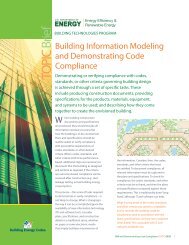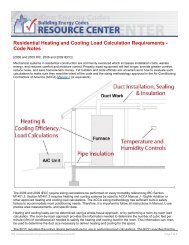Alabama - Building Energy Codes
Alabama - Building Energy Codes
Alabama - Building Energy Codes
Create successful ePaper yourself
Turn your PDF publications into a flip-book with our unique Google optimized e-Paper software.
Table A.1.<br />
Heating Equipment Shares<br />
Heating System<br />
Single-Family<br />
Percent Share<br />
Multifamily<br />
Natural gas 28.9 1.8<br />
Heat pump 69 94.1<br />
Electric resistance 2.1 4.1<br />
Table A.2.<br />
Foundation Type Shares<br />
Foundation Type Slab on Grade Heated Basement Unheated Basement Crawlspace<br />
Percent share 44.1 8.6 10.6 36.7<br />
Table A.3.<br />
Construction by <strong>Building</strong> Type and Climate Zone<br />
Climate Zone<br />
Housing Starts<br />
Single-Family<br />
Multifamily<br />
2 1,577 94<br />
3 – Warm humid 1,594 798<br />
3 – Not in warm humid region 5,531 764<br />
Differences Between the 2006 IECC, the 2009 IECC, and the 2012 IECC<br />
All versions of the IECC have requirements that apply uniformly to all climate zones, and other requirements<br />
that vary by climate zone. Highlights of the mandatory requirements across all buildings include:<br />
• <strong>Building</strong> envelope must be caulked and sealed. The 2012 IECC adds a requirement that the building<br />
must be tested and a level of leakage that is no more than a maximum limit must be achieved.<br />
• Ducts and air handlers must be sealed. Testing against specified maximum leakage rates is required in<br />
the 2009 and 2012 IECC if any ducts pass outside the conditioned space (e.g., in attics, unheated<br />
basements). The 2012 IECC leakage requirements are more energy efficient.<br />
• Supply and return ducts in attics, and all ducts in crawlspaces, unheated basements, garages, or<br />
otherwise outside the building envelope must be insulated.<br />
• For the 2009 and 2012 IECC, a minimum percentage of the lighting bulbs or fixtures in the dwelling must<br />
be high-efficacy lighting.<br />
• A certificate listing insulation levels and other energy efficiency measures must be posted on or near the<br />
electric service panel.<br />
A comparison of significant IECC requirements that do not vary by climate zone is contained in Table A.4. Of<br />
these, the most significant changes in the 2009 and 2012 IECC compared to the 2006 IECC are the requirements<br />
for pressure testing of the building envelope and ducts/air handlers, and for insulating service hot water pipes<br />
(2012 IECC only). The requirement for high-efficacy lamps, while significant, is somewhat abated by a<br />
superseding federal regulation banning the manufacture or import of less efficient lamps at common watt levels<br />
that takes effect in 2012 to 2014.<br />
A.3 April 2012
















